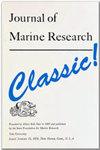卡里蒙贾瓦国家公园福丹岛勒贡海岸羔羊植被的碳入侵
IF 0.5
4区 地球科学
Q3 Earth and Planetary Sciences
引用次数: 0
摘要
大气中的高二氧化碳气体可能引发全球变暖。为了减少不良影响,需要采取一些缓和措施,其中之一是利用海草作为一种被称为蓝碳的碳汇的碳。这项研究的目的是确定在卡里蒙加瓦国家公园勒贡罗孚海滩的海草植物的生物质量和碳含量。2021年11月28日至29日,两站进行了研究。对植被的分析是通过经转化器的方法进行的,这是参考海草林监测手册的参考。海草核取样。海草的生物群落分为下部和下部(根和根部)。海草的生物质量是由干重和干燥来决定的。碳含量是通过干旱的LOI或干粉方法获得的。研究发现了五种海草,包括酶淀粉、地中海贫血、Cymodocea rotundata、Halophila ovalis和Halodule uninervis。草甸的情况比较温和。亚底拉特下的生物质量比亚底拉特下的生物质量(585 g/m2)要大(346.73 g/m2),然后比亚底拉特上的碳含量(182.54 gC/m2)要大(119,43 gC/m2)。研究地点的草本植物可能储存301.97 gC/ m2的碳。大气中的高二氧化碳气体可以触发全球变暖。减少努力需要减少额外的广告,因此被称为蓝色碳的乐观主义所利用。这项研究旨在确定在勒贡犁海滩、科木加岛、卡里蒙加国家公园的生物质量和碳满足的估计。本研究于2021年11月28 - 29日第二阶段进行。蔬菜分析是通过使用行的transtriquadd方法进行的,该方法指的是LIPI Seagrass指南。海草样本由海草核收集。Seagrass biomass分解成叶子和下胚(根和根)。seagrass生物量的价值通过烤箱中的干燥过程确定。海底填充价值是通过丢失或干燥固定的方法获得的。研究结果显示,包括五种海带菌,包括T. hemprichii, C. rotunity, H. ovalis和H. uninervis。海草草的情况是保密的,因为我们有一个现代的封面。下生物量的价值(585 g/m2)比生物质量指数的价值(346.73 g/m2)更大,在其子部后面跟着碳成分的值(163.54 gC/m2),比在海拔139.43 gC/m2更大。研究地点的海草植被具有本品301 gC/m2碳的潜力。本文章由计算机程序翻译,如有差异,请以英文原文为准。
Penyerapan Karbon Pada Vegetasi Lamun Di Pantai Legon Bajak Pulau Kemujan, Taman Nasional Karimunjawa
Gas karbondioksida yang tinggi di atmosfer dapat memicu pemanasan global. Upaya mitigasi diperlukan untuk mengurangi dampak buruk, salah satunya dengan pemanfaatan lamun sebagai penyerap karbon yang dikenal dengan blue carbon. Penelitian ini bertujuan mengetahui estimasi biomassa dan kandungan karbon pada vegetasi lamun di Pantai Legon Bajak Pulau Kemujan, Taman Nasional Karimunjawa. Penelitian dilakukan pada 28 – 29 November 2021 dengan dua stasiun. Analisis vegetasi dilakukan menggunakan metode line transect quadrant, yang mengacu pada buku Panduan Monitoring Padang Lamun LIPI. Pengambilan sampel lamun menggunakan seagrass core. Biomassa lamun terbagi menjadi bagian atas substrat (daun) dan bawah substrat (akar dan rhizoma). Nilai biomassa lamun ditentukan melalui berat kering dari dengan cara pengeringan. Nilai kandungan karbon diperoleh melalui metode LOI (Loss of Ignition) atau pengabuan kering.Hasil penelitian diperoleh 5 jenis lamun, antara lain Enhalus acoroides, Thalassia hemprichii, Cymodocea rotundata, Halophila ovalis dan Halodule uninervis. Kondisi padang lamun tergolong memiliki penutupan sedang. Nilai biomassa yang terdapat di bawah substrat (585 g/m2) lebih besar dibandingkan yang terdapat di atas substrat (346,73 g/m2), diikuti dengan kandungan karbon di bawah substrat (182,54 gC/m2)yang lebih besar dibandingkan atas substrat (119,43 gC/m2). Vegetasi lamun di lokasi penelitian berpotensi menyimpan karbon sebesar 301,97 gC/ m2. The high level of carbondioxide gas in the atmosphere can trigger global warming. Mitigation efforts are needed to reduce adverse impacts, such as by the optimization of seagrass as a carbon sink which is known as blue carbon. This study aims to determine the estimation of biomass and carbon content in seagrass vegetation at Legon Bajak Beach, Kemujan Island, Karimunjawa National Park. The research was conducted on 28 – 29 November 2021 at two stations. Vegetation analysis was conducted by using the line transect quadrant method, which refers to the LIPI Seagrass Monitoring Guidebook. Seagrass sample was collected by using seagrass core. Seagrass biomass is divided into above substrate (leaves) and below substrate (roots and rhizomes). The value of seagrass biomass was determined through dry weight by drying process in the oven. The value of carbon content in seagrasses is obtained through the LOI (Loss of Ignition) method or dry ignition.The results o the study obtained 5 species of seagrasses, including E. acoroides, T. hemprichii, C. rotundata, H. ovalis and H. uninervis. The condition of seagrass meadows is classified as having moderate cover. The value of the biomass below substrate (585 g/m2) is greater than the value of biomass above the substrate (346.73 g/m2), followed by the value of carbon content below the substrate (182.54 gC/m2) which is greater than above substrate (119.43 gC/m2). Seagrass vegetation in the study site has the potential to store 301.97 gC/m2 of carbon.
求助全文
通过发布文献求助,成功后即可免费获取论文全文。
去求助
来源期刊

Journal of Marine Research
地学-海洋学
自引率
0.00%
发文量
1
审稿时长
3 months
期刊介绍:
The Journal of Marine Research publishes peer-reviewed research articles covering a broad array of topics in physical, biological and chemical oceanography. Articles that deal with processes, as well as those that report significant observations, are welcome. In the area of biology, studies involving coupling between ecological and physical processes are preferred over those that report systematics. Authors benefit from thorough reviews of their manuscripts, where an attempt is made to maximize clarity. The time between submission and publication is kept to a minimum; there is no page charge.
 求助内容:
求助内容: 应助结果提醒方式:
应助结果提醒方式:


